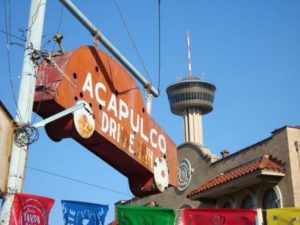
Acapulco Drive Inn in Southtown
I have somewhat mixed emotions on the closing of Acapulco Drive Inn. On the days it was open (very sporadically) it was a great place for neighbors to gather and catch up. I have a couple of neighbors that swear their dog would not let them walk by without them first stopping for a beer. It was a great place to stop by before or after walking to NIOSA or other Fiesta Events.
If you’re looking for another great neighborhood ice house to fill the void be sure to check out The Friendly Spot Ice House in the heart of Southtown. http://www.thefriendlyspot.com/
My hope is that the now vacant Acapulco will be taken over by another group that will fully utilize its prime location at the entrance of Southtown and add some vibrancy to the space.
This article in the Express-News does a good job of explaining the history of Acapulco Drive Inn, the role of an ice house, and the reason it is closing down.
Southtown’s Acapulco Drive Inn ice house closes
By Joel Williams Contributing Writer
Published Monday, November 21, 2011
In its day, the Acapulco Drive-Inn served the Southtown area as a popular gathering spot for a diverse crowd, ranging from construction workers to FBI agents needing a place to unwind.
But the Acapulco, in business at 609 S. Alamo since the early 1970s, had seen better days by the time it closed at the end of October after a run of nearly four decades of good food and inexpensive beer.
It joins a list of other “ice houses,” the term for neighborhood beer joints that usually offered an open-air experience, which have closed down in recent years.
Maria Ester Guerra, whose parents, Juan and Hilaria Guerra, took over the business in 1978, remembers the Acapulco as a family-oriented place. Her family as well as customers felt comfortable with their children there.
She also remembers that Friday night would draw a crowd to the Acapulco Drive-Inn, because that was when her late father cooked the place’s renowned carne asada.
“Everybody knew that on Friday my daddy would make brisket and people would start showing up around 9 or 10 at night,” Maria Guerra said.
Her mother’s gorditas also were popular.
Tamales were a mainstay during the winter, but it would close during January for her parents to take some vacation.
Because her parents worked there most days, she and her siblings and their children spent a lot of time at the Acapulco working as well as having family get-togethers.
“One of my sisters got married there,” Guerra said. “We had all of our birthdays, Mother’s Day, Father’s Day. All of our memories are there.”
They had to meet there if they wanted to see her parents, she said.
“All of our memories are there,” she said.
Ice houses got their name from the places where people used to buy blocks of ice that made their refrigerator (then known as an “ice box”) cold.
They evolved into community hangouts in post-World War II America.
As the name implies, ice houses started out as places where people collected blocks of ice to put in their ice box — an insulated but non-refrigerated container that kept the cold in and preserved food and drink.
“Ice houses once were neighborhood anchors, pivots around which much of San Antonio’s social life revolved,” said Char Miller in a 2009 interview with the Southside Reporter, who taught environmental and urban history at Trinity University for 27 years and is author of “Deep in the Heart of San Antonio: Land and Life in South Texas.”
“Not unlike parishes, icehouses came to define sections of town-the food they served; the chilled drinks they sold; the music they played, like the languages their patrons spoke, reflected the city’s diversity of cultures and folkways,” said Miller, who is now director of the environmental analysis program at Pomona College in Claremont, Calif.
Ice houses became the local gathering place where the post World War II working class and emerging middle class in San Antonio could buy a loaf of bread or other groceries, sit down for a cerveza (beer) or game of dominoes or just hang out and talk about the weather, politics, football or family.
Nowadays there are far fewer ice houses on the North Side, but they remain a stronger presence on the West Side and East Side and probably strongest on the Southside.
The Acapulco Drive Inn was a place for everyone from FBI agents from the nearby federal building, who would gather there on Thursday nights, to staff from nearby Spanish-language radio and television stations also felt at home there, as well as people from the neighborhood.
Guerra said her parents, who leased the building, brought in extra income charging for parking during Fiesta, and during Spurs games when the NBA team played downtown in HemisFair Arena and later at the Alamodome.
But, several years ago, after her father died and her mother was getting too frail to keep up with the business, one of Maria Ester’s brothers tried to make a go of it. He finally decided that the return on time invested was not paying off.
“All things end,” Guerra said. “That’s the way the Lord has it.”
